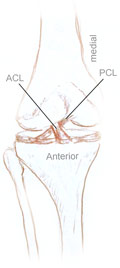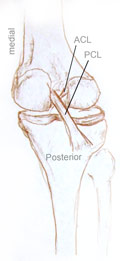What is an ACL injury? - Anterior Cruciate
Ligament injury?
The ACL which is short for anterior cruciate ligament is one of four
knee ligaments that connects the upper leg bone with the lower leg bone.
It is located at the front of the knee within the joint. It prevents the
tibia bone (lower leg bone from slipping forward) and also stabilizes the knee when pivoting.
The ACL is just a little ligament but is plays a big role in knee stability.
The Cause of an ACL injury?
The ACL is most commonly damaged by a sudden twisting force where the
lower leg is twisted out (tibia external rotation). It can also
be caused by a hyperextension. This is done when the knee joint folds
back too much.
Different ACL injuries
The severity of the tear is categorized as mild, moderate or a complete tear. A mild ACL tear can heal with rest and proper exercise. A complete tear may need surgery or you could live with mild knee pain and instability. You have to be a little careful in yoga classes in either case.
How to Diagnose an ACL injury
One of the first ways to diagnose a knee injury is with a physical examination by a professional. A good physical therapist
will be able to test and diagnose the affected muscles and ligaments with stress tests. However to truly find out the severity of the
injury use devices that show actual images of the damaged ligament.
These are as follows:
Radiographic Evaluation - Radiographers use radiation equipment to produce
images of the knee. Skilled profesional can identify the cause of the problem.
MRI - Magnetic Resonance Imaging is a way in which a varying or changing magnetic field
is used to produce pictures of any part of your body. MRI�s are often used for serious knee injuries.
This allows proper evaluation of the knee with clear imaging of other damage to ligaments or cartilage.
KT 1000 - measures the amount of slide between the upper and lower bones in the knee joint.
Over the years teaching in Denver, Colorado I saw many ACL injuries.
This was due to the number of skiers in its population.
A sudden twist of the lower leg either inward or outward can cause the ACL to be overstretched resulting in serious injury.
Unfortunately this is a common event in skiers. Many postures in Yoga can re aggravate or destabilize the knee joint.
Be careful when bending and twisting the knee joint. Avoid doing this if it aggravates the knee which is common. Yoga classes can be really beneficial for knee injuries but be careful and don't feel bad about modifying things. Get through a yoga class without aggravation but with having strengthened and stretched the knee.
|

Adho Mukha Svanasana
Avoid hyperextending the knee joint in these great hamstring and calf muscle stretches.
Push into mild boundaries when stretching.


Paschimottasana is a seated forward bend in yoga. It is a good way to
stretch the hamstrings. Place a towel or blanket under the legs to prevent hyperextension if straightening aggravates pain.


Balasana the Child Pose in Yoga can be a good way to stretch the legs.
Enter boundaries that are more mild than those in the posture shown. If the knee is swollen be very careful. Stretching into mild boundaries will increase range of motion and give a general good feeling within the joint.
 Salamba Kapotasana
Salamba Kapotasana
Use support with the arms when entering and holding these kind of yoga postures. They can really aggravate a knee condition and further destabilize the knee. Another great trick which allows you to perform this posture is to bring the knee towards the midline of the body. This reduces the twist in the knee joint.
ACL injury
Meniscus injury
Patella Tracking
|